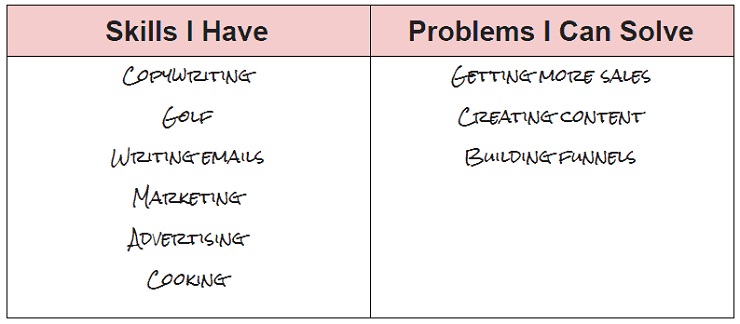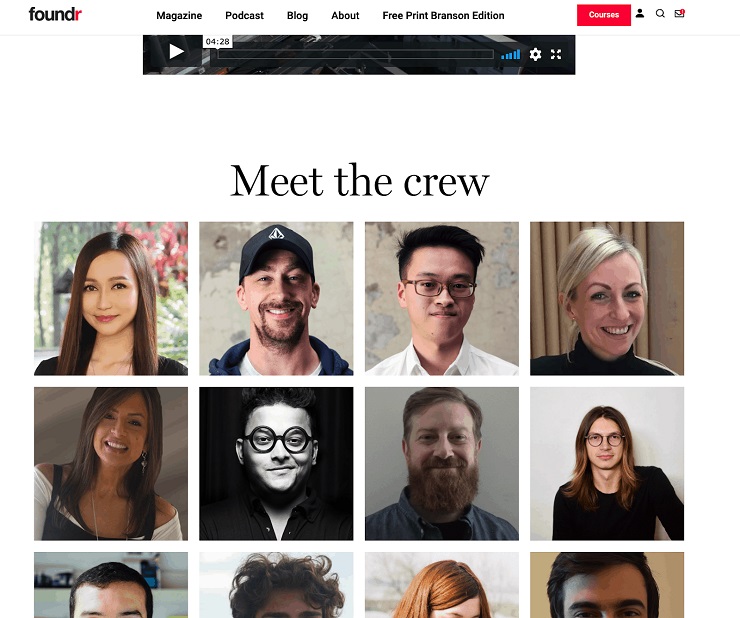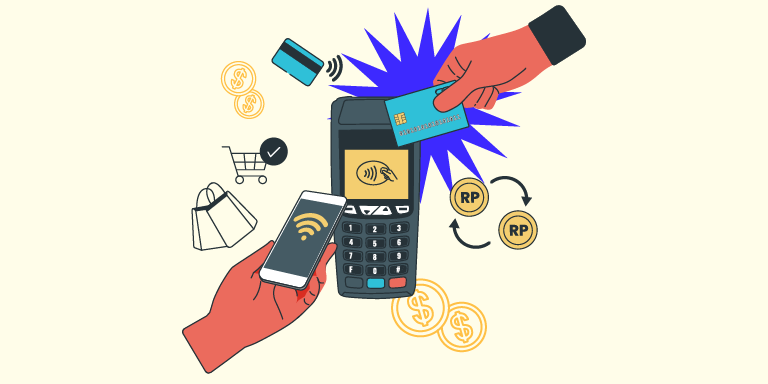I recently stumbled onto my worst nightmare: A 6,000-word post on the “65 best side business ideas.” Are there really 65 “best” of anything? I don’t think so.
Assuming you could get past the sheer size of this list of business ideas, you’d find some real gems, such as:
- Doing surveys
- Becoming a mermaid (yes, really)
- Shoveling snow
Name one person on the Forbes billionaires list who got rich from any of that.
But even if you’re not looking to become a billionaire, this list represents a huge misconception that plagues entrepreneurship—that you need some genius idea (or 65!) in order to start your own business.
In reality, starting a side business from home is a lot more straightforward than all that. What you actually need is a clear path to hit real, significant milestones—preferably fast, too.
Today, that’s what I want to share: A legitimate, proven plan for starting a side business from home, even if you have little or zero money, right now.
Whether your goal is to start a side hustle that makes an extra grand a month, or you want to eventually quit your day job, this post will guide you through five key steps to making your first buck in the next 30 days.
This is not speculation. I’ve used this exact method to start and grow my own side business from $0 to over six-figures a year. And I’m nobody special!
Table of Contents
Step 1: Uncover the Real Reason You Want to Start a Side Business—Then Fund It
Step 2: Forming You, Inc.
Step 3: Uncovering Your MVS, Minimum Viable Skill Set
Step 4: Getting Your First Paying Client
Step 5: Make Your First $1,000
Bonus! The Tools That Power $50K/Month Freelancers and Consultants
Step 1: Uncover the Real Reason You Want to Start a Side Business—Then Fund It (Day 1)
When you decide to start a side business from home, it’s tempting to jump right into the tactics, like building your website, making client calls, or creating Facebook ads.
But the truth is, rushing in with this scattershot approach will almost always lead to failure. It’s far better to slow down and spend a little time planning than it is to get three weeks (or worse, months!) into an idea, only to realize it’s never going to work out.
I’ve been guilty of this. A few years ago, I thought I had a brilliant idea to start a side business teaching people how to improve their social skills. The market for people who want help with social skills is huge, so I thought I would be able to make a lot of money fast.
But six months after launching my social skills site, I realized that I had no passion for this topic. Worse, without narrowing my focus down to one particular niche, it wasn’t a profitable one either.
In the end, all that I had to show for a half a year of work was a domain name (that I let expire) and a $17 ebook I wrote (and sold a mere two copies of).
You can avoid this mistake by doing just a bit of preparation beforehand. That starts with getting clear on why you want to start a side business.
- Is it because you have an entrepreneurial itch you want to scratch?
- Is it because you want to build a real business and eventually quit your day job?
- Do you want some extra money you can use to go on fun vacations and fund your lifestyle?
Whatever your why is, it’s important you know, because it will change how you approach it. For many of you, entrepreneurship is in your blood. Maybe you can’t wait for the day you can leave your day job and be your own boss. If that’s you, great. Many of the most successful entrepreneurs started their businesses while they had a day job.
But that does mean you’re going to need to carve at least a few hours every week to make progress toward your goal of being your own boss.
A word of warning: If immediate cash is your biggest goal, consider taking a step back before starting your side business.
Chasing quick riches is what caused my social skills website to fail. Because making quick money drew me in, I made decisions that ultimately hurt me in the long run. And the reality is, you’re never going to build something you’re happy about if turning a quick profit is your primary focus.
That said, I do want to share a couple of ways to get some extra money in your pocket fast, like this week. This will help you be calm and level headed about the side business you go on to build.
3 Ways to Put Money in Your Pocket Now to Fund Your Side Business
- Cut Unnecessary Subscriptions. One of the fastest ways to put some extra cash in your pocket is to print out your bank or credit card statement and start cutting unnecessary subscriptions. These can be products you don’t use or products you don’t really need. It might shock you how fast little bills you’re paying for add up. For example, when I went through this exercise I found that I was paying for:
- LinkedIn Premium: $29.99/month
- Winc (a subscription wine box): $59.00/month
- Audible: $22.95/month (I love this service but I’m way behind on the books I currently want to get through. So pausing temporarily won’t hurt.)
- A sleep aid supplement: $26.95/month.
Those four things were costing me $138.89 every month, without even thinking about it. Cutting them was like instantly saving $1,666.68 per year. Even if you’re not tight on cash, I urge you to go through this exercise. It might shock you how much money you can save to invest in your side business.
- Renegotiate Your Salary. Another quick way to put some extra money into your pocket is to go to your boss and ask for a raise. Of course, you can’t just stumble into their office and demand more money. But if you’re strategic about finding how much you’re worth and prepare for the conversation, it doesn’t have to be confrontational at all. It can just be a conversation between you and your boss—that results in you making $1,000-$10,000 more per year. For a five-minute conversation, you really can’t beat that ROI. Not to mention, negotiation is a skill you’ll need if and when your side business takes off.
- List 2 Items On eBay. If you’re going to start a side business from home, it’s time to get used to selling things and making your own way. To get a taste of that, I recommend you choose two items that you rarely (or never) use anymore and list them on eBay. That Christmas present you never opened? Time to sell it. For me, I listed my old iPhone 4 and a pair of shoes I never wore anymore. After shipping cost and fees, I made $76.22. A life-changing amount of money? No. But that’s $76.22 I didn’t have before, and now that I’ve done it I know I can do something similar every month to make between $500-$1000 a year—just by getting rid of things I don’t use anymore.
Once you reduce stress by clarifying why you want to do this, and freeing up some extra cash, you can move on to step two.
Step 2: Forming You, Inc. (Days 2-4)
Becoming an entrepreneur isn’t as difficult as most people think. We’ve been led to believe you’ve got to come up with an idea as grand as Google or Instagram.
But the truth is, entrepreneurship doesn’t have to be so complicated. And it doesn’t require an app, a website, or any of those things you might expect. In fact, I didn’t have any of those things when I made my first $50,000 from my side business.
What you do need is a simple system for finding a problem you can solve and getting paid for it.
If you’re looking for the fastest and simplest way to get started in entrepreneurship, consider becoming a freelancer or consultant. You can be in business with as little as a smartphone and laptop (sometimes even less!). You don’t have to spend months building a product or creating an online course. You can charge money for your services, starting as soon as today! And you can leverage the skills you already have.
You just need a reputation for getting results.
For example, I don’t have a degree in marketing. I write copy for a living and I never studied English or grammar. But it doesn’t matter, because as a freelancer or consultant, all you need to do is deliver results. That’s what people pay for.
How much can consultants make? Check out this four-minute video, in which a millionaire consultant breaks down different ways to make money as a consultant. You’ll see how you could charge as much as $1,500 per hour with a consulting business and even break away from the time vs money equation altogether.
Remember, you can always add digital products, software, and other ecommerce products to your freelancing or consulting practice later on. But if you want the fastest and simplest way to start a side business from home, this is what I recommend.
First, take an inventory of your skills. Just take a piece of paper, draw a line down the middle, label one side “Skills I Have” and the other “Problems I Can Solve.”
Like this:
What are you insanely good at? If you’re stuck, here are some sample questions to get you started:
- What do you read about on Saturday mornings when everyone else is asleep?
- What do you do for work?
- What could you talk about for hours on end?
- What skills do you really want to get better at?
- What problems are you already solving for businesses (aka your job)?
Go crazy with this. Write down every idea that comes to mind. From that list, you can start to get an idea of the type of freelancer or consultant you can be. (By the way, if you’re interested in becoming a copywriter, check out this list of 31 blogs and books that helped me learn how to sell millions of dollars of product online.)
For me, it’s clear that I can help businesses get more sales and leads with content. So at a high level, I can position myself as a content marketing consultant.
For you, it might be helping businesses streamline their financial operations or doing design work or video editing. Whatever your unique skill set is.
Common Question: What if the only skill I have is what I do for work?
Answer: It’s common for people to take a component of what they do in their day job and turn that into their first side business from home. That’s what I did! And many freelancers and consultants start this way.
The key to creating your own You, Inc. is deciding what problem you can and want to help people solve. Don’t think about pricing or where you’ll get clients just yet. For now, just choose what type of freelancer or consultant you’ll become, then move on to step 3.
Step 3: Uncovering Your MVS, Minimum Viable Skill Set (Days 5-7)
Once you’ve picked the type of freelancer or consultant you’ll be, it’s time to identify the services people will pay you for. In the product world, people call this creating a minimum viable product or MVP.
But as a freelancer or consultant, your product is actually YOU. So I like to think of it as finding your Minimum Viable Skill Set, or MVS for short.
Imagine your freelance or consulting business like a restaurant. This step is where you find what items to put on the menu for people to order. The last thing you want is to offer a menu that nobody wants.
There are two easy ways to know if people will pay for your service(s):
- See if people are already paying for this. This is the easiest way to find out. Go to job listing sites like Upwork or Freelancer.com and see if people are already doing the type of work you want to do. Competition is a good thing! It proves there’s a market for what you want to do. For example, when I go to Upwork and search for copywriting jobs, I see 796 job listings!
That proves there’s demand for copywriting services. And if I click through a few of the listings I can get a sense of the types of jobs people want help with. I see people need help with the copy in their stores, emails, and landing pages. As you see these things, take note of them. Remember, you’re not going to get your clients on these sites but you are building a menu of potential services you can offer.
- When you talk to a potential customer, do they ask, “Can I pay you to do that?” That’s right, talk to people! If you mention your idea to your target market, do their eyes light up? Do they ask how they can pay you for your services? If so, that’s proof your idea is solid. Getting this kind of reaction is a good sign.
You can adapt these services later on but make sure you get a good grasp of your offerings before moving on to the next step.
Step 4: Getting Your First Paying Client (Days 8-14)
Repeat after me: “I will not overcomplicate getting clients, especially in the beginning.”
One of the biggest mistakes I see people make is they think they need lots of fancy tools, a portfolio, Facebook page, etc, before they can ever land clients. But the truth is, none of those things are important when you’re just starting out.
For example, I even documented how I made $9,000 in one month, with nothing more than a Gmail account and Google Docs.
The most important thing, especially at the beginning of your side business, is landing one paying client.
Before that, nothing else matters.
So here’s what you want to do.
First, make a list of 30 dream clients. Who are the people and companies that immediately come to mind when you think, “Yes, that’s the kind of person or business I can help.” Write them down with a pen and paper, or a spreadsheet, as I prefer.
Second, find the decision-maker’s email address. Now it’s time to find out how you can get in contact with these dream clients. For example, as a copywriter, I often need to reach out to CMOs, marketing managers, and in some cases the company’s founder.
So I’ll go on LinkedIn or the company’s website to find this information. For example, if I was looking to get in touch with Foundr, the first place I’d go is their About Us page.
Scroll down and you’ll see the “Meet the Crew” section:
I’m looking for a marketing manager. In this case, it would be David Hobson, the head of digital strategy and growth.
His email isn’t available on the site, but that’s no problem. You can use a free Chrome extension called Clearbit Connect to find it. If all else fails, I recommend cycling through the common emailing conventions.
Nine times out of 10, you’ll figure it out in less than a minute.
Third, send your cold outreach email. Here’s a sample script you can use. This script has personally been worth over $37,000 in booked clients for me.
——————————
SUBJ: [[Introduction]] [[your name/company]] <> [[their name/company]]
Hey [[NAME]],
I know you’re busy and get a lot of messages, so this will only take 48 seconds of your time (read fast!).
My name is [[YOUR NAME]] and I help [[who you help and what you help them do]].
Specifically, I’m a [[tell them what kind of consulting work you do specifically and how it relates to them]].
I recently noticed you [[mention something relevant they just did, like an email, Tweet or new product launch]], and I knew I could help.
If you’re even the slightest bit curious about what [[your service]] might do for your business, would you be open to a quick 7-minute chat?
I promise to give you some ideas you’re free to steal. If you play your cards right, I might even tell you the lamest joke I know!
Finally, it’s time to release my favorite weapon.
A picture of [[something funny]].
Just what you’ve always wanted:
[[fun picture]]
I await your profanity-filled response 🙂
Have an absolutely terrific day,
[[Your Name]]
Title
—————————–
The beauty of this script is that it’s simple, playful and fun.
Note: I’m not hard-selling in this email. I just pitch the idea of hopping on a call. And the call is where I’ll talk more about how I can help. I don’t want to scare would-be prospects away with a blatant sales pitch in the first email.
Also, don’t be worried if you don’t hear back from everyone you email. It takes some follow up and time. And in the end, only one in every five people will probably ever respond.
Rather than letting that stop you, just aim for 30 in your initial outreach push. From there, you should be able to get five or six people on the phone, and be able to close at least one into your first deal.
For more on how to write cold outreach emails that absolutely crush it, read this post and this in depth post on getting consulting clients from scratch.
Step 5: Make Your First $1,000 With Your Side Business From Home (Days 15-30)
Once you book a call with the potential client, you might be wondering, “What do I say??”
Don’t let this part stress you out. These conversations will feel more natural with practice. But just start them the way you’d start any conversation. Ask them to tell you a little bit about themselves and their business.
If you can make any connections as they explain, do that. But after a bit of small talk, you’ll want to move into the next part: Finding their pain point.
It can be as simple as saying: “Got it. So what’s slowing you down the most with regard to [[your service]]?
After you ask this question, you’re going to want to shut up and listen very closely to what they say. Because how they answer will tell you how to position your offering.
They’ll probably tell you something like, “I don’t have time for it” or “I don’t know how to do it” or “I’m disorganized.”
When they finish, validate how they feel and then say, “I think I can really help you. Here’s how…”
And that’s where you explain the specific type of service you offer and when you could deliver the finished service.
I always like to end by saying, “So if I sent you over a proposal for how I could do [[x, y and z services]] for you by [[such and such date]], would you be ready to get started with a test project?”
Most of the time, they’ll either say yes or tell you what they need to be ready to go. This also lets you take some time to itemize your services and come up with a price to charge in your email.
Because of the way you listened to their problems in the beginning, it won’t feel confrontational or salesy. You’ll just be speaking to how you can help and the pain points they already told you.
Follow those five steps, and you’ll be on your way to getting your first paying client in the next 30 days—no doubt. But if you want more advanced training on closing clients, setting your rates and sending proposals that work, be sure to check out the advanced guide on how to build your consulting or freelance empire here.
Bonus! The Tools That Power 5 Freelancers and Consultants Making Up to $50,000 Per Month
While we’re on the topic of starting your side business from home, I wanted to share what five successful freelancers and consultants use to power their day.
Steven Young, an SEO consultant who charges $1,000 per hour, uses:
- Timeular Time Tracker. “It’s a physical time tracker that’s easier for me than using Toggl.”
- Folding Bluetooth Keyboard. “It’s small enough to fit in a coat/bag/back pocket and turns my phone into a good enough laptop imitation that I can spontaneously work at coffee shops/parks/etc. I love it!”
Michael Nguyen, a six-figure video production consultant, says, “Now that I’m thinking about it, I use a lot of crap to run my business. It might be time to simplify! Nevertheless, here’s my must-have list:
- Wunderlist: Where I can list weekly tasks that need to get done. It’s great for listing goals and things I want to do in the future too.
- OneDrive: Where I send and receive media assets needed to complete projects.
- Razer Orbweaver: I can set different macros and hotkeys on this device, which helps me video edit quickly.”
Kaleigh Cox, a professional copywriter in the top 1% of freelancers on Upwork, says, “To power my work from home business, I pretty much just use Google Drive and Slack all the time. I keep things pretty simple.”
My past client and friend Ryan Robinson runs a side business that generates over $50,000 per month and he recommends Trello and ToDo for iPhone to stay productive on the go.
For me personally, I recommend:
- Some type of email tracking, scheduling, and template-based inbox service. Email is the engine that drives my freelance writing business. It’s not going to drive traffic to my website in the long run, but it’s perfect for kickstarting conversations. So having a service that helps me automate following up, seeing if people opened my emails and scheduling is key. Consider checking out Close (Disclaimer: this is one of my past clients).
- Lastpass. I am the world’s worst with remembering passwords. So rather than resetting my password (and wasting valuable time) every time I need to log in to a service, I prefer to let LastPass.
- Grammarly. As a one-man shop, there’s nobody other than me proofing my copy before I send it out to clients. And even though it might seem like a minor thing to say “their” instead of “they’re” by accident, clients notice that. So I just prefer to have someone catch those silly mistakes before I send any copy out. And Grammarly makes that easy with their plugin.
But in the end, it’s not the tools that make the entrepreneur. It’s the entrepreneur that makes the tools.
So, what are you waiting for? You have a plan. You have the scripts. You have the tools. Now it’s time to go, go, go.
One more thing…
Do you have any questions about starting or growing your side business from home?
As someone who’s personally launched a side business from home, I’m here to help!
Whether you’d like me to expand on unconventional ideas for getting clients, outreach scripts or any copywriting business specific questions, fire away.
I’ll be hanging around in the comments, responding to people.
So leave a comment. And help share this message with people who need to read it.






















